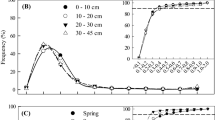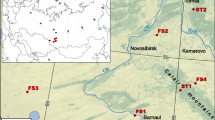Abstract
Variability of fine root (diameter < 2 mm) distribution was investigated in four 55 to 56-year-old Maritime pine (Pinus pinaster) stands using a combination of trench wall observations and destructive sampling. Our objectives were to assess patterns of fine root distribution, to estimate tree fine root biomass and to explore interactions with understorey vegetation in a gradient of relevant site conditions. Results showed that root density decreased with soil depth in all stands, and variability appeared to be highest in litter and subsoil layers especially where compacted soil layers occurred. Roots were clustered in patches in the top 0–50 cm of the soil or were present as root channels at greater depths. Cluster number, cluster size and number of root channels were comparable in all four stands. Overall fine root biomass at depths of 0–120 cm ranged from 2.7 to 7.2 Mg ha−1 and was highest for the two driest stands. The use of trench wall records made it possible to reduce the variability of these estimates. Understorey species represented as much as 90% of the total number of fine roots in the upper layers, and the understorey formed a considerable proportion of the total ecosystem biomass, suggesting that understorey species are likely competitors for nutrients in this ecosystem. Further studies should focus on the interaction of the understorey and pine roots and the ecological significance of clustered roots and nutrient distributions.





Similar content being viewed by others
References
AFNOR (1999) Qualité des sols, vol 1: recueil de normes. AFNOR, Paris
Bakker MR, Augusto L, Achat DL (2006) Fine root distribution of trees and understorey in mature stands of maritime pine (Pinus pinaster) on dry and humid sites. Plant Soil 286:37–51
Baldwin JP, Tinker PB, Nye PH (1972) Uptake of solutes by multiple root systems from soil: II. The theoretical effects of rooting density and patern on uptake of nutrients from soil. Plant Soil 36:693–708
Bengough AG, Castrignano A, Pages L, van Noordwijk M (2000) Sampling strategies, scaling and statistics. In: Smit AL, Bengough AG, Engels C, van Noordwijk M, Pellerin S, Van de Geijn SC (eds) Root methods: a handbook. Springer, Berlin, pp 147–173
Bert D, Danjon F (2006) Carbon concentration variations in the roots, stem and crown of mature Pinus pinaster (Ait.). For Ecol Manage 222:279–295
Bolte A, Villanueva I (2006) Interspecific competition impacts on the morphology and distribution of fine roots in European beech (Fagus sylvatica L.) and Norway spruce [Picea abies (L.) Karst.]. Eur J For Res 125:15–26
Bouillet J-P, Laclau J-P, Arnaud M, M’Bou AT, Saint-André L, Jourdan C (2002) Changes with age in the spatial distribution of roots of Eucalyptus clone in Congo. Impact on water and nutrient uptake. For Ecol Manage 171:43–57
Casper BB, Jackson RB (1997) Plant competition underground. Annu Rev Ecol Syst 28:545–570
Coomes DA, Grubb PJ (2000) Impact of root competition in forests and woodlands: a theoretical framework and review of experiments. Ecol Monogr 70:171–208
den Ouden J, Vogels D (1997) Mechanical resistance by an ectorganic soil layer on root development of seedling Pinus sylvestris. Plant Soil 197:209–217
Eppard HR, Horton JL, Nilsen ET, Galusky P, Clinton BD (2005) Investigating the allelopathic potential of Kalmia latifolia L. (Ericaceae). Southeast Nat 4:383–392
Hodge A (2004) The plastic plant: root responses to heterogeneous supplies of nutrients. New Phytol 162:9–24
Jackson RB, Manwaring JH, Caldwell MM (1990) Rapid physiological adjustment of roots to localized soil enrichment. Nature 344:58–60
Jackson RB, Canadell J, Ehleringer JR, Mooney HA, Sala OA, Schulze ED (1996) A global analysis of root distributions for terrestrial biomes. Oecologia 108:389–411
Jose S, Williams R, Zamora D (2006) Belowground ecological interactions in mixed-species forest plantations. For Ecol Manage 233:231–239
Laiho R, Finér L (1996) Changes in root biomass after water-level drawdown on pine mires in southern Finland. Scand J For Res 11:251–260
Meredieu C, Colin A, Teissier Du Cros R, Chantal M, Porté A, Loustau D (2005) Evaluation des stocks de carbone dans la biomasse de peuplements de Pin maritime: application à l’échelle régionale. In: VIII ARBORA Colloquium “Carbone, forêt, bois: impacts du changement climatique, stratégies pour la filière?”, ISTAB, Bordeaux, 1–2 Dec 2005, pp 143–159
Nambiar EKS, Sands R (1992) Effects of compaction and simulated root channels in the subsoil on root development, water uptake and growth of radiata pine. Tree Physiol 10:297–306
Nye PH, Tinker PB (1977) Solute movement in soil-root system. Blackwell, Oxford
Park BR, Yanai RD, Vadeboncoeur MA, Hamburg SP (2007) Estimating root biomass in rocky soils using pits, cores, and allometric equations. Soil Sci Soc Am J 71:206–213
Parker MM, van Lear DH (1996) Soil heterogeneity and root distribution of mature loblolly pine stands in piedmont soils. Soil Sci Soc Am J 60:1920–1925
Pierret A, Moran CJ, Doussan C (2005) Conventional detection methodology is limiting our ability to understand the roles and functions of fine roots. New Phytol 166:967–980
Read DJ, Leake JR, Perez-Moreno J (2004) Mycorrhizal fungi as drivers of ecosystem processes in heathland and boreal forest biomes. Can J Bot 82:1243–1263
Robinson DA (1994) The response of plants to non-uniform supplies of nutrients. New Phytol 127:635–674
Schenk HJ, Jackson RB (2005) Mapping the global distribution of deep roots in relation to climate and soil characteristics. Geoderma 126:129–140
Schmid I, Kazda M (2005) Clustered root distribution in mature stands of Fagus sylvatica and Picea abies. Oecologia 144:25–31
Smith SE, Read DJ (1997) Mycorrhizal symbiosis, 2nd edn. Academic, London
Stone EL, Kalisz PJ (1991) On the maximum extent of tree roots. For Ecol Manage 46:59–102
Sudmeyer RA, Speijers J, Nicholas BD (2004) Root distribution of Pinus pinaster, P. radiata, Eucalyptus globulus and E. kochii and associated soil chemistry in agricultural land adjacent to tree lines. Tree Physiol 24:1333–1346
van Veldhoven PP, Mannaerts GP (1987) Inorganic and organic phosphate measurements in the nanomolar range. Anal Biochem 16:45–48
Werno J (1984) La Lande mésophile à Fougère aigle [Pteridium aquilinum (L.) Kuhn]. Influences des facteurs stationnels et sylvicoles sur la production et le fonctionnement de l’écosystème. Ph.D. thesis, Université de Bordeaux I, France
Acknowledgments
We thank Christian Barbot and Sylvie Niollet for their help in digging soil pits and Elise Jolicoeur for the chemical analyses. Laurent Augusto is thanked for his valuable suggestions on data handling and useful comments about an earlier version of the manuscript. We are grateful to the owners of stands S1 and S2 in the local forest area of “Le Barp” for allowing us to use their stands for this study, and the INRA Hermitage Experimental Unit is thanked for maintenance and access to stands S3 and S4 in “Saint Alban” experimental forest.
Author information
Authors and Affiliations
Corresponding author
About this article
Cite this article
Achat, D.L., Bakker, M.R. & Trichet, P. Rooting patterns and fine root biomass of Pinus pinaster assessed by trench wall and core methods. J For Res 13, 165–175 (2008). https://doi.org/10.1007/s10310-008-0071-y
Received:
Accepted:
Published:
Issue Date:
DOI: https://doi.org/10.1007/s10310-008-0071-y




